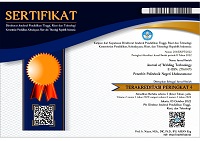Desain tangki timbun external floating roof kapasitas 75000 MT
Abstract
Keywords
Full Text:
PDFReferences
PT. TPPI, “Rencana Induk Terminal Khusus,” Tuban, Jawa Timur, 2017
S. Pullarcot, “Above Ground Storage Tanks Practical Guide to Construction, Inspection, and Testing”’ US. Taylor & Francis Group, Florida, 2015
N. Nugraha, “Perilaku Nonlinier Pipa Elbow Bertekanan Yang Diberi Beban Termal Dan In-Plane Bending,” 2018.
American Petroleum Institute, “ API 650 Standart Welded Tanks for Oil Storage Tank (Vol. Twelft),” API Publishing Service. Washington D.C., 2013
AMEtank reference manual, Technosoft inc, Cincinnati, 2014
U. Brawijaya, “Modul Training Ansys Workbench PT. BOMA BISMA INDRA”, Pasuruan, 2014
S. Y. Kuan, “Design, construction and operation of the floating roof tank,” Research Project of University of Southern Queensland, Australia, 2009
J. Fang, W. Huang, F. Huang, L. Fu, and G. Zhang, “Investigation of the Superposition Effect of Oil Vapor Leakage and Diffusion from External Floating-Roof Tanks Using CFD Numerical Simulations and Wind-Tunnel Experiments,” Processes, vol. 8, no. 3, p. 299, 2020.
F. Lestari and W. Nurdiansyah, “Potensi Bahaya Kebakaran Dan Ledakan Pada Tangki Timbun Bahan Bakar Minyak (Bbm) Jenis Premium Di Depot X Tahun 2007,” MAKARA, vol. 11, no. 2, pp. 59–64, 2007.
I. F. Akbar, H. Yudo, and I. P. Mulyatno, “Analisis Kekuatan Tangki Penyimpanan Crude Oil 38T-104 Berbentuk Silinder dengan Tipe External Floating Roof pada PT Pertamina RU IV Cilacap,” J. Tek. Perkapalan, vol. 8, no. 1, 2019.
DOI: http://dx.doi.org/10.30811/jowt.v2i2.2063
Refbacks
- There are currently no refbacks.

This work is licensed under a Creative Commons Attribution-ShareAlike 4.0 International License.
Ciptaan disebarluaskan di bawah Lisensi Creative Commons Atribusi-BerbagiSerupa 4.0 Internasional.
Mailing Address:
Politeknik Negeri Lhokseumawe
Jl. Banda Aceh-Medan
Km. 280,3, Buketrata, Mesjid Punteut, Blang Mangat,
Kota Lhokseumawe, 24301
Propinsi Aceh,
Indonesia























